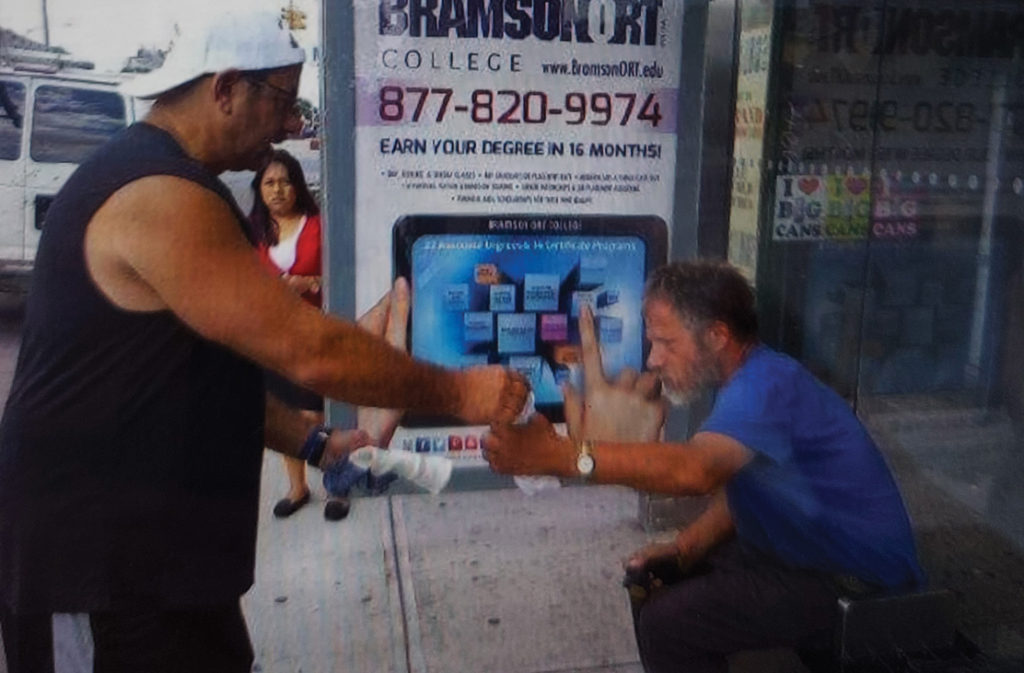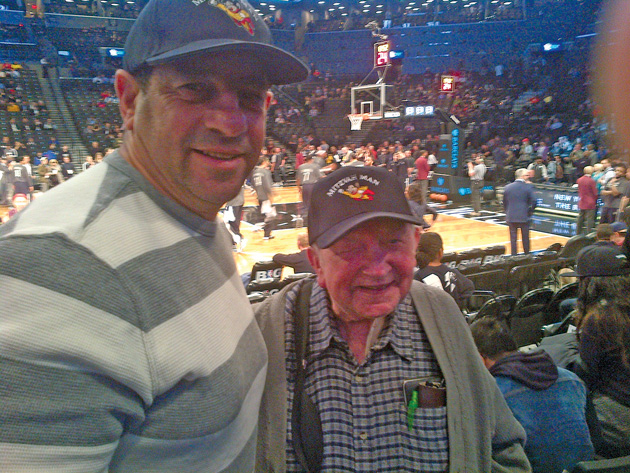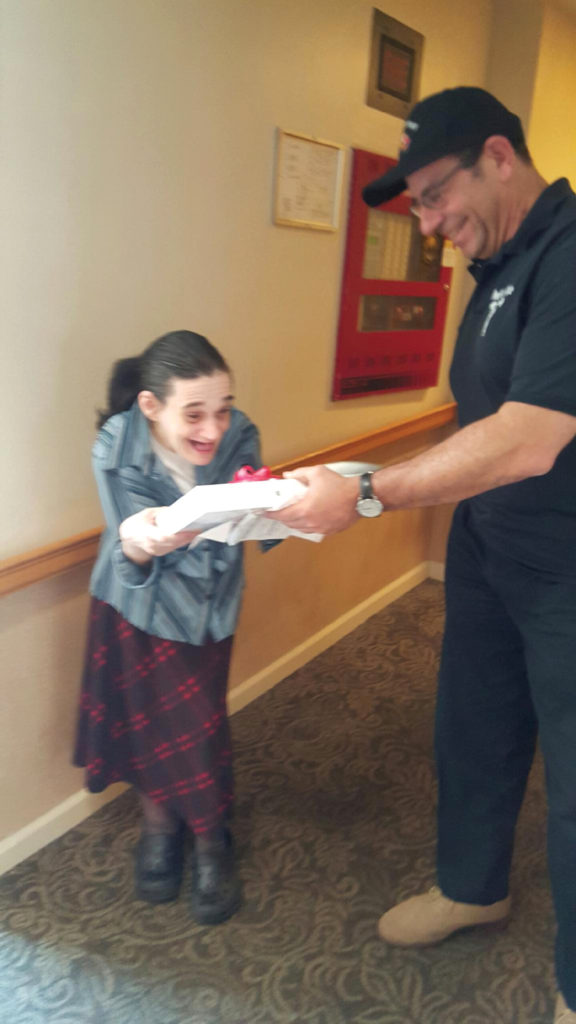
FOR SEVERAL YEARS NO ONE EVEN KNEW HIS NAME. HE WAS SIMPLY THE MITZVAH MAN, HELPING PEOPLE OUT ANONYMOUSLY. FOR THE PAST DECADE, THE MITZVAH MAN HAS BEEN DOING HESED, ACTS OF LOVING KINDNESS, FOR PEOPLE EVERYWHERE. HOW DID MICHAEL COHEN BEGIN THIS WORK? WHAT WAS THE IMPETUS?
At age 50, Michael Cohen began to take stock of his life. Thankfully, he had a good family, three healthy children, a home, business, and a stable career as a personal trainer. His business, Body By Mike, gave him a few hours each afternoon of free time—since most clients were seen before and after work.
Michael began to spend more time praying and learning. He wanted to do something meaningful, something that would help people. He was fit and healthy and he had a car. So, he began with a simple advertisement: “Mitzvah Man – Available for All Your Needs” with his cell number and a picture of Mighty Mouse.
Calls began to come in. “Can you put tefillin on my father?” “Would you read to a blind person, take a senior citizen to synagogue, deliver food, help move furniture, visit the sick?”
Michael volunteered with Sephardic Bikur Holim two days a week visiting patients in hospitals. He read a Halacha book called Visiting the Sick that gave him guidance on how to visit people. He learned not to stay too long or give them advice. The goal was to make them feel good. He also volunteered for Aishel Shabbat and Bnai Raphael, both food organizations, to increase his level of hesed.
Michael would pick up a get well greeting card before visiting and put his name and contact information in the card, so the people he visited could call him when they left the hospital. This took the mitzvah to a higher level. During the next two years, he visited more than 500 people—even some in jail.
One day he received a request to drive an older woman on errands. Michael cleaned his car, put on soft music and went to pick up the woman. When he arrived, he got out of the car and held the door for the woman and her husband, as if they were getting into a limousine. He made them comfortable and offered them coffee. The idea was to maximize the deed and not rush it. He took his time. “If you rush it, you water down the mitzvah,” he said. The couple was honored that he held the door for them and treated them with such respect.
The word hesed occurs 246 times in the Torah, indicating its level of importance. For Michael, hesed wasn’t just about doing a good deed, it was doing it with all your heart, putting himself in the other person’s shoes and really understanding the situation. “By feeling their pain and being anonymous, you reach a higher level,” he said.
On another mitzvah, a woman needed to go to city to see her 40-year-old son who had cancer. Michael picked her up with a hot bagel to eat and fresh coffee. He waited in the car while she was in the hospital, listening to a Torah tape. The woman was so grateful, she wanted to hug Michael. He took her to visit her son the next day as well.
One time, Mike saw a homeless man in the street with no shoes and socks. It was winter and cold. He took off his own socks and gave them to the man. As it turned out, someone on the street snapped a picture and put it on social media. It turned out that the man had been missing for three weeks and his family was happy that he was okay. He was from a group of 40 or so Jewish homeless people taking shelter in a local synagogue. The Mitzvah Man got them all socks, shoes, coats, pillows and clean blankets.
Word spread like wildfire about the Mitzvah Man! He became so busy that every hour of his noon to 6 P.M. free time was filled. He was helping 20 to 25 people a week. Soon he was overwhelmed.
One day, David ‘Hurdle’ Tawil A”H and his son Elliot called to say, “We love what you are doing. It’s time to make an organization!” They pushed Michael to take the hesed to an even higher level and recruit volunteers who would be an extension of the Mitzvah Man. David and Elliot called their friends and raised startup funds for the organization.



The ads changed—the Mitzvah Man needed volunteers. Hundreds of people answered the ad. He interviewed them, explained the idea and got references. Volunteers kept coming. Each had an idea of what sort of hesed he/she wanted to do. Some wanted to visit a house of mourning, help with a minyan, and cook a meal, others wanted to visit the sick, or put on tefillin.
The organization created a system. They tried to match a donation with a need. When furniture gets donated, they try to find someone who needs it. They have found chair lifts, hospital beds and other items, they even found a washing machine for a woman who needed it desperately.
Today, the Mitzvah Man has more than 3,500 volunteers in Brooklyn, 250 or so in the Deal area and some in the other New York boroughs. They fill 70 to 80 new requests each week, helping about 130 people. In total, there are about 12,000 mitzvot performed a year. The Mitzvah Man also has a database and referral system which helps people find the assistance they need. They don’t only help people, afterwards a staff person follows up on each situation. When calls come in for aid they are returned within 20 minutes on average. “Responding quickly shows those in need that we care,” said Michael.


There are also many ongoing weekly acts of hesed. And like anything else, there are bumps in the road. As an athlete, Michael knows how important it is to motivate people and he’s great at inspiring the volunteers.


Michael hopes that the Mitzvah Man motivates people to do more and raise their level of hesed. To volunteer or request hesed, visit www.themitzvahman.com, a 501-c-3 not-for-profit organization.
A journalist, genealogist and historian, Sarina Roffé is the author of Branching Out from Sepharad (Sephardic Heritage Project, 2017). Sarina holds a BA in Journalism, an MA in Jewish Studies and an MBA.



